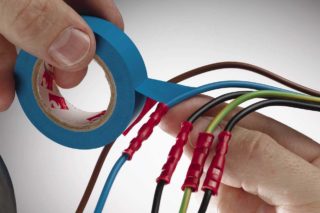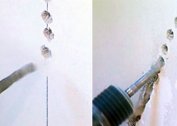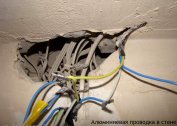Thermal insulation for the electric network is mandatory, it performs a number of functions. The main task is to prevent direct human contact with live parts, to protect the network itself from thermal, mechanical and chemical effects.
Have wires always been insulated?
Already at the first stages of the use of electricity, it was known that the wiring would have to be insulated. Today, plastic, rubber, and other low-cost insulation materials are used as insulation, and their service life will be long.
In the recent past, ineffective, but expensive materials were used. Uninsulated wires were also found, which were marked with a corresponding plate so that people would be careful about them.
Electrical Wiring Requirements
The material intended for insulation has not only dielectric properties, but also performs a protective function. Considering the installation method and conditions of use, other requirements may also be imposed on insulation.
- Long service life, high degree of resistance to aging.
- High abrasion and tear resistance.
- Resistance to temperature effects, especially high temperatures.
- Lack of possibility of excesses.
- Chemical resistance.
The requirements for the insulating material vary depending on the mechanical effects of the environment, mechanical loads, conductivity in the environment of use.
Coupling and its insulation
The connector is used in cases where it is necessary to extend the wire, for example, when carrying a switch or socket. The coupling, together with the wiring, will be sealed in the wall, so its insulation must be tight. The most reliable option in this case is the use of a heat shrink tube. When choosing, the degree of its shrinkage is taken into account. As a rule, triple shrinkage is typical for this part, it is important to consider this when choosing the required diameter. Isolation is carried out in several stages - first of all, lived, and then the rest of the site.
As soon as the cores are connected, the tube is pulled to the end of the wire.
Conductor insulation
The places where the cores are connected are isolated with an ordinary electrical tape, but the contact will be thicker and it will be more difficult to put a heat shrink tube on it. As an analog, it is preferable to use a special heat-shrink material. Shrinkage is carried out using an ordinary lighter or building hair dryer.
Insulation layer
At this stage, the insulation of live parts should already be completed, and for the complete and reliable sealing, the clutch shell is additionally processed. This especially plays an important role in the coupling of sheath cables or wires. The tube must hide the connection and find at least 1 cm on both sides of the outer insulating layer, otherwise there is a possibility of dust and moisture getting under the factory wiring sheath.
Junction boxes
Contact devices in the apartment network are junction boxes. This design is protected from the harmful effects of the environment by the housing and cover. The need to insulate electrical wires will depend on the design features of the equipment.If equipped with clamping blocks, additional protection is not required. If this is not the case, separation of conductors is necessary.
The twist joint is most often used in contact boxes that are not equipped with pads. However, over time, the twist loses its density due to expansions caused by temperature changes and oxidation of the conductors. To do this, tightly twist the stripped ends of the cores clockwise, and then, having put on the cap, it is scrolled in the same direction, with a little effort. The inner cavity of the plastic cap is equipped with a steel conical spring. When scrolling carefully, it fits snugly and crimps the contact. Caps can be produced in different colors and sizes, which will allow you to choose the right contact.
Making twists designed for heavy loads, before insulation, the wires are treated with a special substance intended for electrical contacts. This will reduce the resistance, as well as protect against active oxidation.
Isolation of PPE cannot provide reliable tightness, therefore it can only be used in a special compartment of the contact device. If in the future you need to connect a new line or replace the lamp, the cap is quite simple to remove, which cannot be said about electrical tape.
During the work on the line, you must turn off the power in the shield.
Electrical Insulation
 There are several ways to insulate a wire in electrical appliances.
There are several ways to insulate a wire in electrical appliances.
Insulation of wires with electrical tape
First of all, you need to thoroughly twist all the wires together. If the wire has a large number of cores, it is preferable to simply solder them.
Next, insulating material is taken and the entire cable is carefully wrapped. It is important that eventually two layers come out. Do not allow even the smallest part of the wire to remain uninsulated, this will inevitably lead to a short circuit.
Heat Shrink Insulation
Insulating wires in this way is easy. But it is important to put on the phone at a time when all the wires between them will already be securely connected. Most preferably used for insulation of copper conductors.
After all the wires have been connected, a cap is put on the wire, which needs to be heated. It is best to use a building hair dryer for shrinkage, but if it is not, you can do with an ordinary lighter. In this case, the heat shrinkage should completely tighten on the wire, since the resistance of the insulating layer of the wire will lead to an accident.
Heat shrink is used to insulate wires that are designed to work in a humid environment, water or land.
How to insulate a wire in a wall
It is required to choose plaster at a distance of 3-5 cm from the place of damage on both sides, the depth of the trench is 1 cm. These conditions are required for the unimpeded and high-quality connection of damaged sections of the chain. The next step is to disconnect the wires and make an incision in the insulating layer along the center.
10-15 mm insulation material is removed from the damaged ends of the conductor. If the wiring is old, the insulation is likely to be solid and it will be practically impossible to remove it with a knife under tight conditions. It is better to use the reflow method.
The ends of the copper conductors are covered with a layer of solder iron. Stitching conductors is important from all sides very carefully. Finally, an insulating tube is put on the joint. If a moisture resistant joint is required, the pre-bonded portion can be treated with silicone.
How to secure the use of an extension cord in the garden
To connect garden equipment, extension cords with a degree of moisture protection IP54 are required. If the insulation layer has been damaged, it must be sealed to ensure complete operation safety.This can be done using heat-shrinkable tape. Just wrap it with a wire and heat it with a hairdryer.
During thermal exposure, the insulating substance shrinks, thereby tightly crimping the wire. Also, during shrinkage, an adhesive enhancing the action is released from the inner surface of the insulating material. By the quality of the work performed, the heat-shrinkable tape is not inferior to tubes made of similar material. Another advantage of the building material is that it is possible to use it by a winding method.
Precautionary measures
Before proceeding with the insulation of the wires of the electrical network and household appliances, it is necessary to make sure that the network is de-energized. It is recommended to disconnect the voltage using a special circuit breaker. Next, with a flat screwdriver with an indicator, the presence of voltage at the output is checked - the place where work will be carried out.
When performing work, the quality of the materials used matters. If the material is easily flammable and is afraid of thermal effects, this will inevitably lead to accidents or emergency situations in the future.







